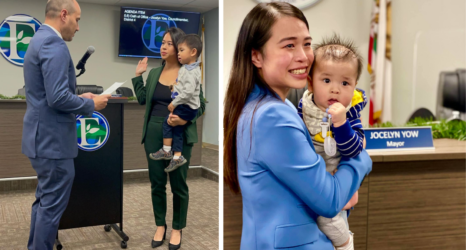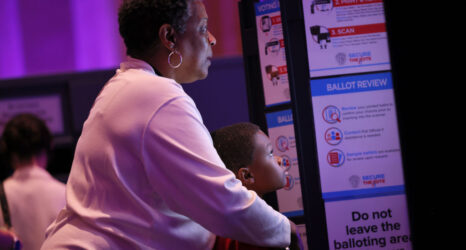This year, women and young people—both as voters and candidates—could have the power to determine the makeup of Congress, state legislatures and governors’ offices.
A national poll released in January by the Washington Post/ ABC News predicts that women’s strong preference for Democratic over Republican candidates (57-31) in congressional races could play a decisive role in determining the outcome of the 2018 midterm elections. And a 2017 survey by MTV/PRRI finds that over the past year, young women were significantly more likely than young men to be engaged in political activity, a finding The Brookings Institute suggests could shift “the course of our politics in the 2018 midterm elections and beyond.”
We saw these trends play out in the 2017 elections, especially in the Virginia races for the state’s House of Delegates. Record numbers of Democratic newcomers, including a record number of women, challenged long entrenched Republican incumbents and won, despite having to campaign in highly gerrymandered districts that favored Republicans. A massive gender gap with 13 percent more women than men (61 percent versus 48 percent) voting for the Democratic candidate Ralph Northam for governor; a colossal African American vote, especially from African American women; and a surge among young voters combined to shift the makeup of the House from a Republican supermajority of 66-34 to a 51-49 bare majority. And that outcome was only final after a tie vote for one House seat was broken by literally drawing a name out of a bowl.
In Alabama’s special election to fill a U.S. Senate seat, the gender gap was again decisive. An extraordinary turnout among African American women, 98 percent of whom voted for Democrat Doug Jones, led the way, putting the Senate in play in 2018. Young voters were a significant if not decisive factor in both the Virginia and Alabama elections. In Virginia, the turnout among 18 to 29-year-old voters surged to 34 percent, up from 26 percent in 2013 and double their 17 percent turnout in 2009. Among young voters, 69 percent supported Northam for governor. In Alabama, young voters again mobilized in record numbers, increasing their turnout to 23 percent to help elect Jones.
Also shaping the 2018 elections are the historic, never-before-seen numbers of women running for office. According to the Center for American Women and Politics (CAWP), 396 women have filed to run for the House of Representatives—80 percent
of them Democrats—breaking the previous record of 298 in 2012. Many are running for the first time and in districts long dominated by Republicans. For the Senate, 50 women are running, the majority of whom (62 percent) are Democrats. That’s an increase from the previous high of 40 in 2016. And at press time time, 79 women are running for governor.
There’s good news for these women candidates: A recent survey of registered voters by the research firm PerryUndem shows more people over the past year have come to believe the country would be better off with more women in political office, jumping 17 points from 52 percent to 69 percent. The largest increase is among Republican women (from 29 to 59 percent). And 73 percent of survey respondents said that stories of sexual harassment in the news have made them think more about sexism in society.
The political impact of this heightened awareness is underscored by the findings of a recent Gallup poll that documented an increase over the past decade in Americans’ discontent with the position of women in U.S. society (37 percent in 2018 compared to 26 percent in 2008). Significantly, the largest increase occurred among Democratic women, jumping from 38 to 62 percent. Among young people, significantly more women than men (63 percent versus 43 percent) believe that women face “a lot of discrimination.”
The turnout of young voters in the 2018 elections will depend on overcoming increasing attempts to suppress their ability to vote—including laws that make it more difficult for college students to register and vote where they go to school. Laws that allow election-day voter registration, online registration, early voting and voting locations on college campuses all facilitate young people’s involvement. Restrictive documentation and voter ID requirements, especially when college students are prohibited from using student IDs, drive down young people’s voting rates.
According to an assessment by Rock the Vote in November 2017, only nine states are “leaders” in policies that encourage student voting; 21 are “slackers” for having a mixed bag with some policies that restrict voting; and 20 are “blockers” with laws on the books that chip away at student voting rights.
The Higher Education Act of 1998 requires that colleges and universities make a “good faith effort” to register students to vote, but in the years since, most schools simply haven’t. Often students are falsely told they cannot register to vote at an address different from their “permanent” address or that their financial aid could be affected if they register at an address different from that of a parent.
Trump and his administration’s policies are behind the discontent among women and young people, and his significantly lower approval rating among women than men is a major driver in the election outlook. The gap has persisted since his election, with 53 percent of men having a favorable view of Trump compared to only 38 percent of women, a 15-point gender gap. His lowest approval ratings are among 18to 29-year-old women, though in no age group does a majority of women approve of the president’s performance in office, according to FiveThirtyEight’s analysis of SurveyMonkey data from more than 600,000 respondents. Moreover, the gender gap in the president’s lower approval ratings and “feelings about his policies or personal history” crosses political party lines, with fewer women than men among Democrats, Independents and Republicans approving of Trump, according to FiveThirtyEight.
The forces driving the public’s preference for women candidates, and the gender gaps in political engagement, are not likely to abate anytime soon. The massive size of the Women’s Marches this January reflected women’s sustained outrage and engagement. The #MeToo movement’s spotlight on the stories of sexual abuse and workplace sexual harassment across every sector and industry is contributing to women’s political mobilization. And the recent domestic violence scandals among White House staff and appointees (and attempts to cover up the incidents) only fuel women’s anger and mobilization.
“The anti-patriarchy movement is going to undo 10,000 years of recorded history,” former Trump chief strategist Steve Bannon recently told Bloomberg News. “The time has come. Women are gonna take charge of society. This…is a definitional moment in the culture. It’ll never be the same going forward.”
We couldn’t agree more. By all indicators, 2018 is shaping up to be the beginning of a decade for women— one for the record books.





